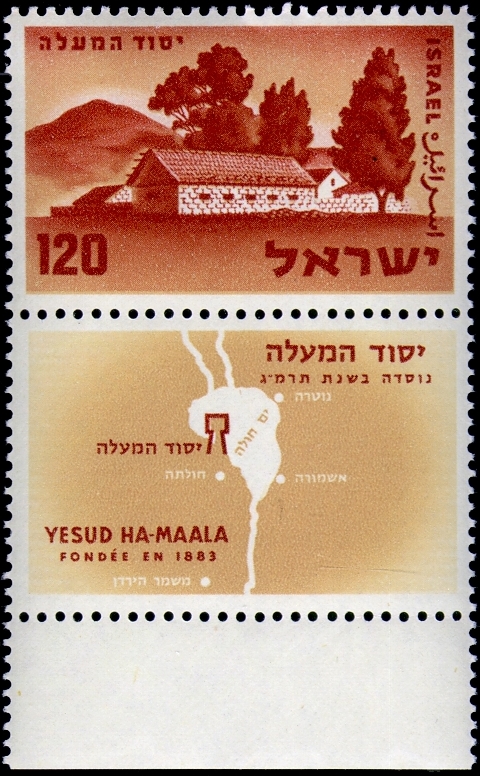Yesud Ha-Ma'ala on:
[Wikipedia]
[Google]
[Amazon]
Yesud HaMa'ala ( he, יְסוּד הַמַּעֲלָה) is a moshava and local council in northern Israel. The moshava was the first modern Jewish community in the Hula Valley. Built in 1883, the community was among a series of agricultural settlements founded during the First Aliyah.Dubrovin
Jewish Agency In it had a population of .
 Yesud HaMa'ala is home to the
Yesud HaMa'ala is home to the
Jewish Agency In it had a population of .
Etymology
The name of the village was taken from a sentence in the Hebrew Bible: "He ( Ezra) determined to go up." (), which was connected to the ZionistAliyah
Aliyah (, ; he, עֲלִיָּה ''ʿălīyyā'', ) is the immigration of Jews from Jewish diaspora, the diaspora to, historically, the geographical Land of Israel, which is in the modern era chiefly represented by the Israel, State of Israel ...
.
Geography
In the late 19th century, the Hulah Valley was mostly swampland and the 15,000 acre (61 km²) shallow Lake Hula. The region was a well-known breeding ground for mosquitoes, and as a result concerns about malaria restricted further Jewish settlement in the region for fifty years. As drainage technology and pesticide use increased in the 1920s, settlement in the area became more feasible. After the1948 Arab–Israeli War
The 1948 (or First) Arab–Israeli War was the second and final stage of the 1948 Palestine war. It formally began following the end of the British Mandate for Palestine at midnight on 14 May 1948; the Israeli Declaration of Independence had ...
and the establishment of the state of Israel, the swamp was drained and converted into agricultural land. Recognizing the unique ecosystem of the valley and its importance as a stopover for migrating birds, scientists lobbied for a small portion of the swamp to remain as a nature reserve. In 1964, the 800 acre (3.2 km²) Hula Valley Nature Reserve, the country's first, was opened.
History
Christian Zionist Laurence Oliphant donated 1,000 roubles to the founding settlers of Yesud Hama’Ala. A census conducted in 1922 by the British Mandate authorities, recorded a population of 142 Jews. With the activation of theNational Water Carrier
National Water Carrier of Israel
The National Water Carrier of Israel ( he, המוביל הארצי, ''HaMovil HaArtzi'') is the largest water project in Israel, completed in 1964. Its main purpose is to transfer water from the Sea of Galilee ...
in 1964, Syrian efforts to disrupt drainage patterns into the Sea of Galilee
The Sea of Galilee ( he, יָם כִּנֶּרֶת, Judeo-Aramaic: יַמּא דטבריא, גִּנֵּיסַר, ar, بحيرة طبريا), also called Lake Tiberias, Kinneret or Kinnereth, is a freshwater lake in Israel. It is the lowest ...
were accompanied by attacks against Israeli farming and fishing activities in the region. Three years later, Syrian forces were repelled further from Yesud HaMa'ala with the capture of the Golan Heights during the 1967 Six-Day War.
On 22 July 2006, a series of Katyusha attacks by Hezbollah
Hezbollah (; ar, حزب الله ', , also transliterated Hizbullah or Hizballah, among others) is a Lebanese Shia Islamist political party and militant group, led by its Secretary-General Hassan Nasrallah since 1992. Hezbollah's parami ...
struck communities in the Hulah Valley during the course of the 2006 Lebanon War
The 2006 Lebanon War, also called the 2006 Israel–Hezbollah War and known in Lebanon as the July War ( ar, حرب تموز, ''Ḥarb Tammūz'') and in Israel as the Second Lebanon War ( he, מלחמת לבנון השנייה, ''Milhemet Leva ...
. In Yesud HaMa’ala, one person was lightly wounded from rocket shrapnel. Prior to the bombings, the community had not seen any hostile attacks since the Six-Day War in 1967. On 29 July three rockets hit Yesud HaMa'ala, lightly wounding a woman and damaging property.
Landmarks
 Yesud HaMa'ala is home to the
Yesud HaMa'ala is home to the Dubrovin Farm
Dubrovin Farm ( he, אחוזת דוברובין) was one of the first farms in the Hulah Valley. It was established by Andrey Dubrovin (1863–1967) who moved to Ottoman Palestine with his family in 1903.
History
Dubrovin left Astrakhan and settle ...
, a museum commemorating the founders of the community, containing personal possessions and furniture from 19th century Russia. Part of the museum includes ruins of a synagogue
A synagogue, ', 'house of assembly', or ', "house of prayer"; Yiddish: ''shul'', Ladino: or ' (from synagogue); or ', "community". sometimes referred to as shul, and interchangeably used with the word temple, is a Jewish house of worshi ...
dating between the 4th and 6th centuries, highlighting the historic Jewish claim to the region. Tel Hazor is very close, even closer than to Hatzor HaGlilit
Hatzor HaGlilit ( he, חָצוֹר הַגְּלִילִית lit. "Hatzor of Galilee") is a town in the Korazim Plateau in northern Israel near Rosh Pinna and Safed. It is named for the nearby biblical site of Tel Hazor. In it had a population o ...
which is named after it (when Yesud HaMa'ala was founded the Tel was not excavated yet).
References
{{Authority control Populated places established in 1883 Local councils in Northern District (Israel) 1883 establishments in the Ottoman Empire Hula Valley Tel Hazor